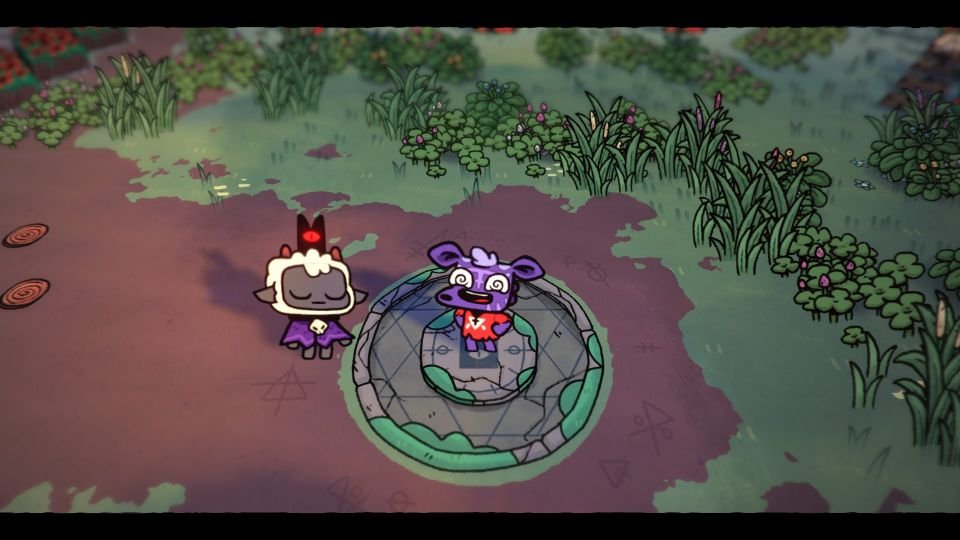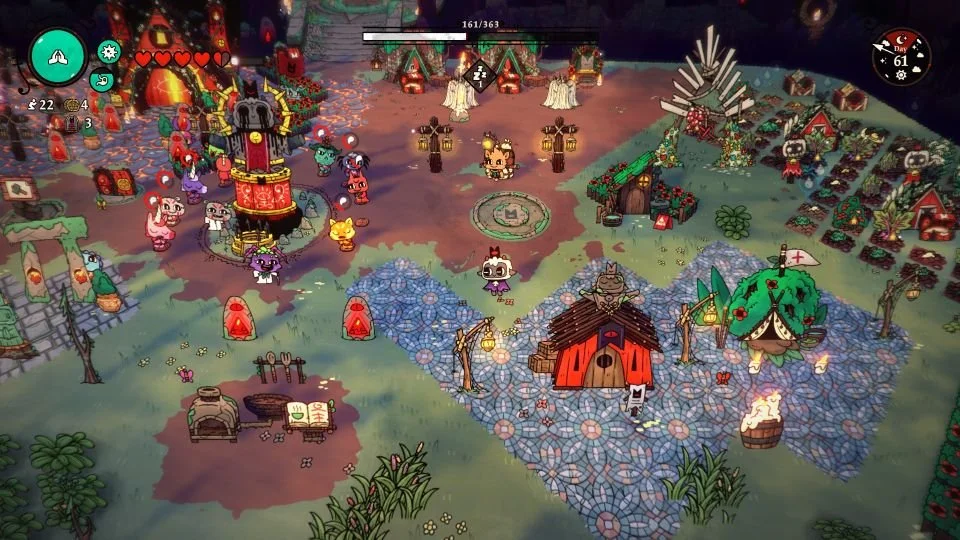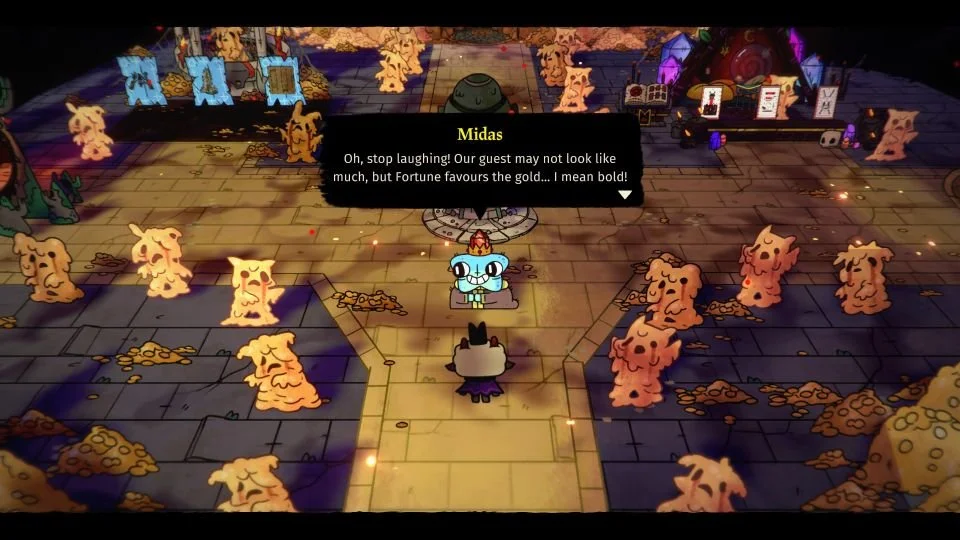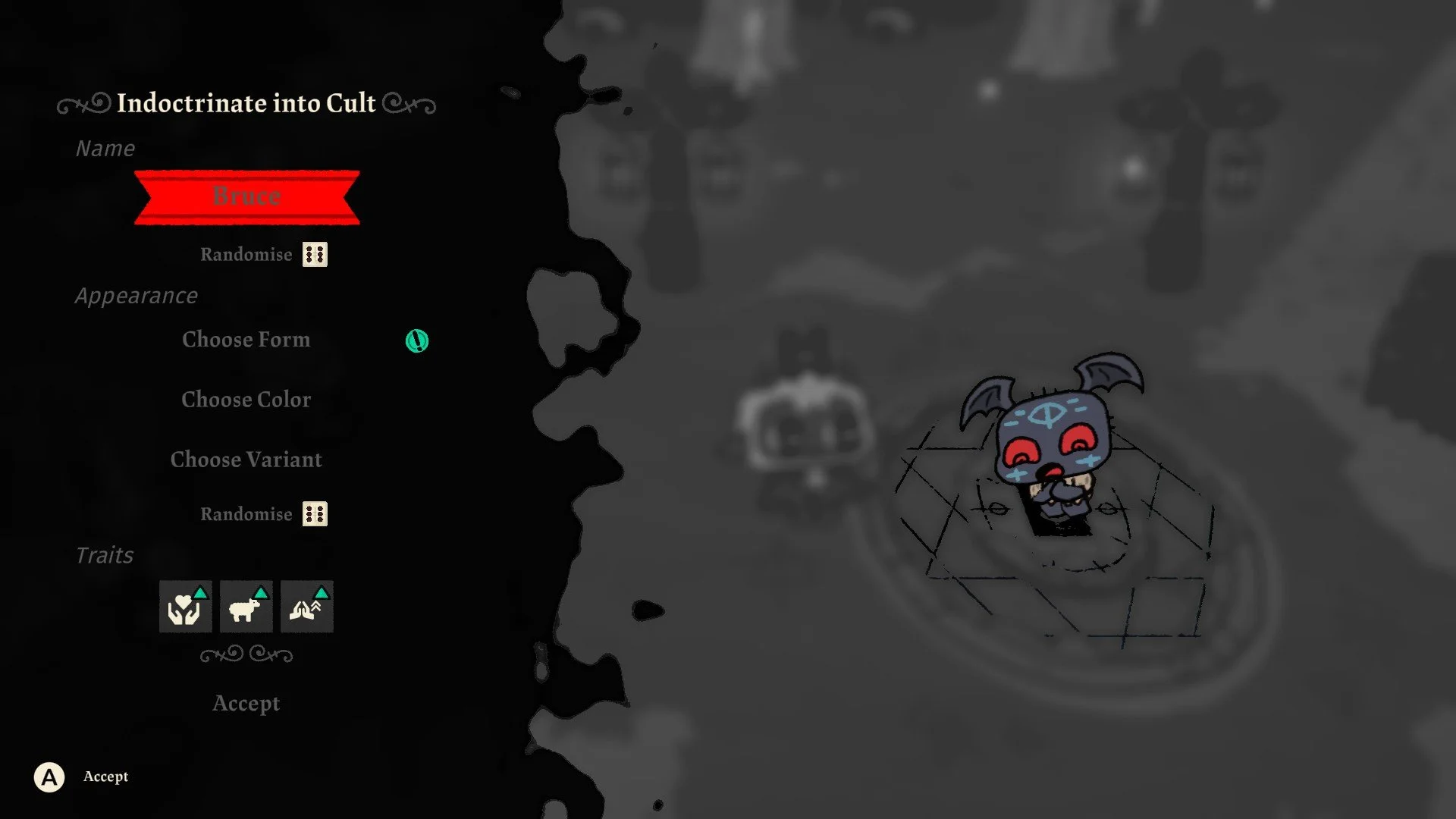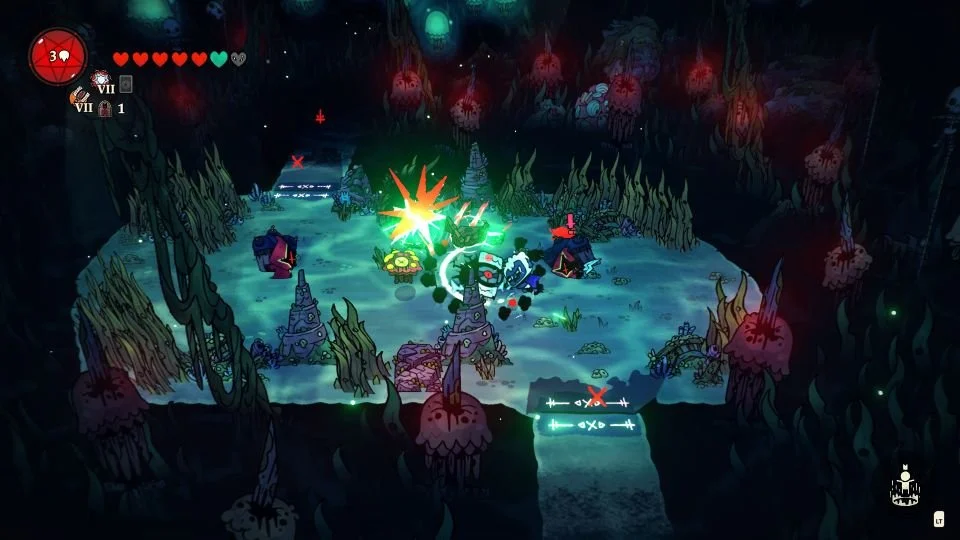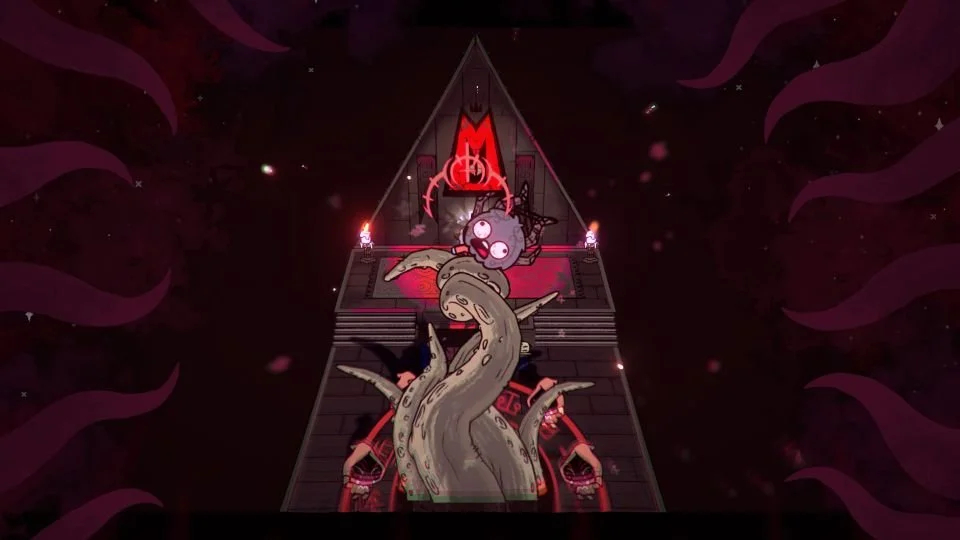Drink the Kool-Aid.
It was a pretty average day at the 2Sheep2Slaughter Cult until Farty, a small little fluffy cultist approached me and thought it would be fun to prank Kibble, a fun-loving little pupper, by making them eat a bowl of poop. While I could disagree with his request and lose some of their faith in me as a result, I instead went along with it, preparing the meal and seeing Kibble proceed to scarf it down. Seeing Kibble then almost vomit immediately pleased Farty so much that once Kibble had recovered from this disgusting act, Farty once again asked me to do it to another member of the Cult. Having enough of Farty’s bullish nature, I ended up sacrificing him to the Cthulhu god that lay deep within the floorboards of my sacred Temple. He died, everyone cheered, and they loved me for it.
Cult of the Lamb sees you overseeing your own demonic cult, bestowed upon you from an equally demonic force that pulls you away from death at the last second at the hands of four evil Bishops; a shadowy group of old gods that were also responsible for the imprisonment of your now current master. As you work towards freeing this mysterious benefactor, you’ll create your cult from literally nothing, recruiting worshipers into your flock as you farm materials to construct a place of worship for you and your disciples, all while ensuring their wants and needs are tended to, whether as a gentle ruler or one of pure evil.
Cult of the Lamb is Game of the Year material at its finest, an experience that is wildly addictive and apart from some technical issues during my pre-release playthrough, was just as fun and crazy as I was expecting, especially from a game under the Devolver Digital banner. While I can continue to work my cult to the bone, burying the dead of those who have aged themselves into the ground, my playthrough of the game was just under the 20-hour mark, but I likely have at least another 20 more while I continue to upgrade various stations, discover more decorations, unlock more types of cultists, or wonder what the heck I am going to do about all these bodies.
Cult of the Lamb has a gameplay loop that is wildly addictive regardless if I was tending to my little village or dishing out some sweet hack and slash violence on one of my dozens of crusades. Each day began with a sermon to my flock, harvesting their faith and devotion in me and then heading out to collect more materials and hopefully find another willing soul to bring back to the camp. Once I would return, victorious from either killing one of the Bishops or one of their grotesque abominations, I would collect the materials my disciples had harvested for me, putting all that hard work and effort back into the camp to make it grow and then ensuring that my followers were fed before they turned in for the night.
The game is essentially a mixture of multiple gameplay styles merged into one overall experience. If you were to take the procedural dungeon-running nature of something like The Binding of Isaac and then offset that with the village-building nature of something akin to Animal Crossing or Cozy Grove, then you would have the basic understanding of what Cult of the Lamb offers, complete with its own unique twisted personality and wonderfully morbid yet cartoonish art style. You’ll balance both of these gameplay types as they often work in unison, having each style of gameplay compliment each other, creating a vastly addictive gameplay loop that never once lost its charm.
When you are first presented with running your own cult, you are given an empty lot to create the living arrangements for yourself and your followers. You’ll have a summoning circle where you’ll greet your newest recruits, a spot to build a shrine in your image, and a crafting station where all your building options reside. You’ll also have a secondary stone circle, but that will be a conversion shop to sell items later on. Lastly, you’ll have an outdoor kitchen, a place to crudely prepare your food, complete with a pretty simple mini-game that increases in challenge for the more potent food items, just make sure to read the pros and cons each dish has so that you don’t accidentally prepare a whole meal that has a high chance of being all too lethal.
While those stations are already present for you as you begin this journey, you’ll first have to construct a temple; the place of worship where you’ll harvest the faith of your followers and perform a series of dark rituals. Your temple, as well as every other structure you’ll have placed around your camp, will be fashioned from harvesting wood, stone, and collecting coins, as well as numerous other resources that you’ll either harvest within your camp via a lumberyard or a mine, but also as you go about your journey to slaughter the four bishops, exploring each of their rogue-like environments. You’ll eventually build a refinery to convert all that wood and stone into more advanced materials, as well as a farm that will be used to grow the crops needed to feed your people. Nearly everything you build or harvest will immediately be put back into growing your cult bigger and better and keeping your flock alive, and yes, this even includes using their poop.
Other necessities also include beds for your followers to sleep in, which can be upgraded into larger tent-like structures that are far more durable and perform double duty as they also will collect some much-needed devotion. You’ll also want to build an outhouse so that you are not having to deal with steaming piles of poop everywhere, which can result in cult members getting sick or losing faith in your capability to run a tight ship. While sick cultists can get over an illness with a few days of bed rest, healing centers can see them become fit as a fiddle in drastically less time, so they will be something you’ll want to invest in when given the chance to do so.
Now, upgrading and even having access to several different structures requires a certain amount of devotion to be built up to earn what is called Divine Inspiration. As you place cultists around your large and imposing shrine, they will feed it devotion. Once you have earned enough, you’ll be able to place a single point into various facilities, upgrading not just your temple or shrine, but making your farm more efficient or being able to create graves for your fallen followers or even being able to craft a scarecrow to keep those pesky birds at bay. This then fills the need of constantly ensuring that your flock worships you, and you can create secondary worship alters that aid in bringing in even more devotion. How effective your cult is will depend on the way you’ve set it up and how you maintain it day by day.
While you’ll have a wide arrangement of the more important facilities to construct and maintain, there are the more novelty-like items like decorative paths or decorations that can liven up the place, and honestly, you’ll often have followers request them as they may find your camp to be a tad boring or too plain for their tastes. As you progress throughout your crusades, you’ll track down NPCs that will open up shops all over a small map that you can frequent whenever you want, as well as one location where you can take in a bit of fishing or a game of dice that is fun but wasn’t anything I found myself doing a lot. Still, these areas are pretty fun to explore and to spend a bit of coin, often bringing back something flashy to your little cult village. You’ll also find a spider salesperson just outside your camp who will sell you a fresh new recruit for some coins that I almost always visited daily to check out his stock. I would say it’s human trafficking, but you’re usually just buying bears, frogs, cats, or various fluffy creatures, so I think it’s on the up and up.
Your cultists are going to be one of the most important aspects of the game to take full advantage of. Each cultist will have a series of traits that will dictate how effective they will be as well as being able to fully customize them as you unlock more types of species to shake up the look of your flock as well as the various names you’ll give them. Everything you do here from giving them gifts or tasks to complete, to even killing a cultist during a ritual can cause their faith to rise or lower depending on their traits. You can reeducate those who lose faith in you, but some of them may be needed to be taken out if they start to pollute the minds of others. Cultists can also get sick and grow old, but if you play your cards right, you can actually bring someone back from the dead or even marry them, which comes with its own benefits.
Another important factor is the temple as worshipping will allow you to unlock new passive traits that help you in your crusades, such as granting you more health, but also better weapons and curses to make your time there more efficient and that little bit easier. As you are out and about on your adventure, you'll track down Commandment Stone Fragments that when you have a full set, you can place points into various doctrines such as Afterlife, Work and Worship, Law and Order, Possessions, and Sustenance. Each of these will dictate particular rules to follow, giving you the choice between two outcomes such as Sustenance offering me the choice between performing a ritual that causes all seeds to be immediately ready for harvest, or making my time with fishing to be more lucrative as not only will I catch double the fish, but special fish will appear more often. To use these doctrines, you will need resources, such as bones, coins, mushrooms, or wood. You'll also have Crown abilities as well that offer up perks like a meal giving you more health before a mission or even changing the color of your robe, which in turn have different passive perks like damage dealt increasing after each kill, but having it reset if you take damage, oh, and you’ll also receive double damage as a result as well.
Now, I’ve mentioned crusades plenty of times already, so let’s dive into just exactly what they are. While the Cult aspect of the game is ensuring your followers are devoted to your cause and following the rules you issue out during your sermons, crusades are the hack and slash action component to this bizarre little package. Crusades take place in one of four different environments that you’ll unlock as you bring followers back to your camp. Each environment is home to a particular Bishop, and as you progress throughout these locations, with I’ll admit, can often look a little too samey, they will torment you and often bring your followers into the mix as well. Each successful run sees you pushing through an entry zone that then breaks up into a multiple-choice path of your choosing, ending in a battle with a boss-like character. As you complete each zone to its completion, you’ll unlock the door to the Bishop, giving you access to take them on.
Each run starts you off with a randomized weapon and secondary ability called a curse. By leveling your temple, you can alter how good those starting weapons and curses can be. You’ll also rely on tarot cards that you’ll find either in chests or from an NPC named Clauneck, who can be found pretty frequently as you explore. These tarot cards can boost your health, make you immune to poison, reveal the map, increase your damage, and more. You can also earn cards from other factors such as marrying one of your followers or winning the dice game against a small group of NPCs.
Weapons themselves range from short to long-range melee weapons like swords and axes, each with stats that detail how powerful it is or how quick or slow they swing. Regardless of whatever I chose, I found each weapon to be very useful, as while the slower weapons take a bit of a wind-up, they can often one-shot most attackers or, at the very least, deal a massive ton of damage. You can also wield special abilities called curses such as emitting an area of effect blast or shooting out a powerful beam that breaks off into smaller individual projectiles, seeking out their victim. I constantly found these to be wildly enjoyable with not a single weapon or curse that I didn’t find great in some way. As you push throughout each environment, you can often happen upon replacement weapons or curses and you can sell your discarded item for gold, or swap back to what you had equipped before and sell off the new item.
Once you have cleared the starting zone, you’ll be presented with a map containing multiple paths you can take on your way to the boss. You’ll have to find the path that works for you as you cannot backtrack or move to a different path. Each location is labeled with an icon to detail if you’ll find wood or stone, a new recruit, or sometimes a mystery location that could be anything from a new NPC to interact with, some ingredients to harvest, or a wealth of devotion to soak up. And, once you have cleared a zone, you can dive back into that completed area to find tougher enemies and the ability to reshuffle an area to just keep going. However, unless you unlock an ability to leave at any time, you may find yourself required to fully finish a zone again in order to leave with all your spoils.
The arrangement of enemies and bosses is very enjoyable, each having their own attack patterns and overall look. I would find these little cultists with crossbows and, upon accident, I swung at their bolt and hit it right back at them. Spiders would leap from above, but telegraph their destination, allowing me to dodge doll into them and crack my axe against their skull. Some enemies would leave a slime trail that would poison me if I stood in it too long, so I would use my curses to attack at them from afar, earning the dropped fervour from their corpses to power up my curses with the ammunition needed to continually use them. Each environment has pots to smash, grass to cut, bones to crunch under your feet, and more, all offering you materials that you’ll eagerly use later. Competing a room will unlock a chest filled with gold or hearts to heal your wounds, and if you find the tarot card to do so, you can upgrade the contents in the chests going forward, but only in that current run.
Whether it is the calming music while I would tend to my camp or the intensity-driven beats while I would be destroying one of the Bishops, the music in Cult of the Lamb is just as enjoyable as its fun cartoony visuals that really make this game pop. The combination of its gorgeous art direction to the crunchy sound effect of collecting resources or pulling in devotion is a match made in heaven, or rather, hell, as I am essentially serving a demon. Everything this game does visually is just fantastic with cute creatures that could be dancing alongside your statue one moment or crushed to death by some demonic creature I summoned in my temple. This game has a truly memorable style to it that is instantly recognizable and doesn’t feel like some copy-and-pasted affair.
Cult of the Lamb can often be dark, morbid, and twisted, but also a game where you’ll laugh your ass off at how silly it truly can be. Creating my cult was incredibly fun, customizing them, naming them, and just getting to know how their traits affect their personality. I would constantly see my favorites either die of some illness or from old age and I would simply go into my temple and bring them back, hoping to see them scamper about to make this cult something truly great. The hack and slash nature of combat, with the arsenal of weapons and curses you wield, was always fun and I never once got tired of it. And thankfully, the same can be said for the day-to-day village maintenance of ensuring 2Sheep2Slaughter was always firing on all cylinders. While a few pesky bugs did affect my time with the pre-release build, I’ll be checking out the game again post-launch, ready to start this whole demonic party all over again.
Developer - Massive Monster. Publisher - Devolver Digital. Released - August 11th, 2022. Available On - Xbox One, Xbox Series X/S, PlayStation 4/5, Windows PC, Nintendo Switch. Rated - (T) Blood, Violence. Platform Reviewed - Windows PC via Steam. Review Access - A review code was provided by the publisher for the purpose of this review.


